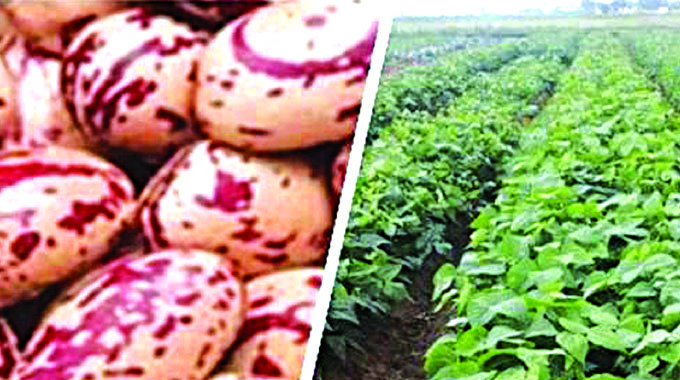
The Sunday Mail

WORD FROM THE MARKET
Cliff Chiduku
SINCE the summer crop planting window has closed, farmers are encouraged to consider short season crops such as sugar beans and cowpeas.
Sugar bean farming is a crucial agricultural activity that contributes significantly to Zimbabwe’s food security and economy.
Besides being a rich source of vegetable protein, dietary fibre, vitamins and minerals, sugar beans contribute to addressing malnutrition challenges within the population. Furthermore, since they are a cash crop, they can provide rural households with income-generating opportunities, thereby contribute to poverty alleviation and rural development.
Depending on agro-ecological zones, sugar beans can be grown at least twice a year, in February and early July. They present local farmers with a good opportunity to diversify their incomes. Since they possess nitrogen fixation properties, they can be grown in rotation with heavy fertiliser feeders such as maize, wheat and cabbage.
Agronomic practices
Sugar beans thrive in well-drained soils with good fertility. They also require the full sun for optimal growth. Farmers are encouraged to rotate the bean crop with other plants each year to prevent diseases and maintain soil fertility. The soil should be kept moist, but not waterlogged, especially during flowering and pod development. Mulching can help retain soil moisture and suppress weeds.
Monitor the plants regularly for pests such as aphids, bean beetles and leafhoppers. Diseases such as powdery mildew and bacterial blight can be prevented by practising crop rotation and proper spacing. Sugar beans are a short-season crop; they are usually ready for harvest between 80 and 100 days after planting, depending on the variety. Harvest when the pods are plump and firm but before they become tough or discoloured. Remove the pods carefully to avoid damaging the plant, then shell the beans.
Market
Sugar beans present promising market opportunities for local farmers. The crop holds significant value both domestically and internationally.
In the domestic market, sugar beans are a staple food for many households, driving consistent demand throughout the year.
The crop can be sold at open markets such Mbare Musika, to supermarkets and non-governmental organisations, and through contract farming schemes. It is quite lucrative to produce sugar beans, which have a return per dollar invested that ranges between US$1,50 and US$2, depending on the agronomic practices employed by the farmer.
Local organisations such as the Grain Marketing Board, PHI and Probrands are paying between US$750 and US$1 100 per tonne of sugar beans.
A kilogramme of sugar beans costs an average of US$1,75 at both Mbare Musika and the Bulawayo central business district market.
A 20kg (20-litre tin) of sugar beans is going for US$25 at Chipadze (Bindura) and Sakubva (Mutare) markets, while at the Nembudziya (Gokwe) market, it is selling at US$30.
The national demand for sugar beans hovers around 100 000 tonnes per year, implying that there is always a supply gap. Internationally, there is a growing demand for high-quality sugar beans, presenting export opportunities for Zimbabwean farmers to tap into regional and global markets.
The sugar bean crop is an important source of vegetable protein. However, there are times when the supply on the local market dwindles.
At the moment, the Agricultural Marketing Authority (AMA) is inundated with buyers looking for huge quantities of sugar beans. Farmers are encouraged to form clusters so that it becomes easy to be linked to markets, especially those outside the country.
To promote increased production of sugar beans, AMA introduced a market linkage programme in village business units across the country.
The programme is tailormade not just to link the farmers with markets, but also to guide production. Under the Presidential Rural Development Programme, it is envisaged that more than 35 000 business units will be established countrywide.
The Ministry of Lands, Agriculture, Fisheries, Water and Rural Development is implementing the programme, with AMA providing market linkages. Zinwa is mandated with development of water infrastructure, AFC provides funding and the Agricultural and Rural Development Authority manages the business units.
The programme is aimed at improving rural livelihoods through the establishment of business units, which are formal companies where villagers double as shareholders and employees.
There is no doubt sugar bean is a valuable crop for farmers looking to diversify their income.
According to the Second-Round Crop and Livestock Assessment Report 2022/2023 season, sugar bean production increased by 23 percent from 25 388 tonnes (t) in 2021/2022 to 31 274t in 2022/2023. The target for sugar bean for the 2022/2023 summer season was 51 015t.
Increased Government support towards the production of the crop, buttressed by good rains from the past season, has yielded immense results.
The national sugar bean productivity is pegged at an estimated 0.87t per hectare, which is low by any standard.
No wonder AMA is encouraging more contractors to come on board and promote sugar bean production through backward integration.
Such interventions are a catalyst for increased productivity owing to the provision of adequate inputs, knowledge transfer, reduced transaction costs and a guaranteed market.
*Word from the Market is a column produced by AMA to promote market-driven production. Feedback: [email protected] or WhatsApp/Call +263781706212.





